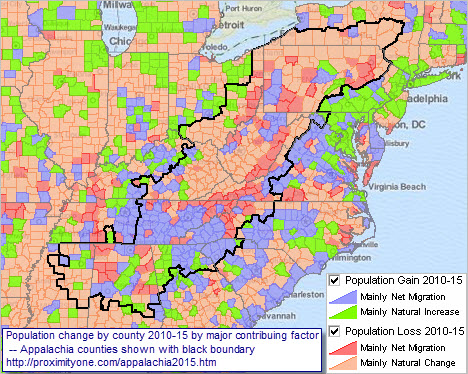

|
|
April 2016. .. examining how is the Appalachia population changing and why .. Appalachia is a region that includes parts of 13 states and has long been challenged with poverty. The population of Appalachia increased from 25,184,339 in 2010 to 25,449,932 in 2015. The extended report below, developed using the ProximityOne Regional Data Analytics tool, in combination with GIS tools provide insights into why, how and where the population change has occurred since 2010. Patterns of Appalachia County Population Trends 2010-2015 Appalachia counties are shown in the following graphic with the black bold boundary. The thematic pattern map shows how counties have gained population (blue and green) and lost population (orange and red) during the period 2010 to 2015. It is easy to see clusters of counties that are increasing or losing population and why. Counties increasing in population are shown by the dominant factor contributing to their growth -- net migration or natural change (where births exceed deaths). Counties decreasing in population are shown by the dominant factor contributing to their population loss -- net migration or natural change (where deaths exceed births). See more detail and access data via interactive table in the County Trends 2010-2015 section. Click graphic for larger view; expand browser window for best quality view.  .. view developed with ProximityOne CV XE GIS and related GIS project. Summary of Population Change Appalachia has increased in population since 2010 due to both net migration and natural increase. The analyses show that during the 2010 to 2015 period, the Appalachia population: • increased by 1,688,832 births • experienced 1,562,810 deaths • had a natural increase (births less deaths) of 126,022 population • increased by 166,990 net international migration • increased by 53,209 net domestic migration • had a net migration of 220,199 population Region & County-by-County Population & Components of Change The RDA report includes eight tables for each county and a summary for the Appalachia region. Tables displayed when using the "Population Estimates & Components" data include: • Table 1 - total population • Table 2 - births • Table 3 - deaths • Table 4 - natural change • Table 5 - international migration • Table 6 - domestic migration • Table 7 - net migration • Table 8 - group quarters population Appalachia Counties & Region: Population Trends & Components of Change; 2010-2015 Click link below to view report. Data for all Appalachia counties, followed the regional summary, are provided table-by-table in the table sequence shown above. • Appalachia region population & components of change 2010-15 Terms of Use The above report may be used for any purpose provided that: 1 - it is not used for commercial, consulting or professional advice purposes. 2 - it is not used in funded research. 3 - all use is referenced as to source with Web URL: -- developed by ProximityOne based in part on Census Bureau data; http://proximityone.com/rda.htm. Using the RDA Resources Use the RDA tool to develop reports like the one shown here for counties and regions of interest. Contact ProximityOne (mention RDA in text section or call 888.364.7656) for more information about using the RDA resources or custom reports. Support Using these Resources Learn more about accessing and using demographic-economic data and related analytical tools. Join us in a Data Analytics Lab session. There is no fee for these one-hour Web sessions. Each informal session is focused on a specific topic. The open structure also provides for Q&A and discussion of application issues of interest to participants. ProximityOne User Group Join the ProximityOne User Group to keep up-to-date with new developments relating to metros and component geography decision-making information resources. Receive updates and access to tools and resources available only to members. Use this form to join the User Group. Additional Information ProximityOne develops geodemographic-economic data and analytical tools and helps organizations knit together and use diverse data in a decision-making and analytical framework. We develop custom demographic/economic estimates and projections, develop geographic and geocoded address files, and assist with impact and geospatial analyses. Wide-ranging organizations use our tools (software, data, methodologies) to analyze their own data integrated with other data. Follow ProximityOne on Twitter at www.twitter.com/proximityone. Contact us (888-364-7656) with questions about data covered in this section or to discuss custom estimates, projections or analyses for your areas of interest. |
|
|